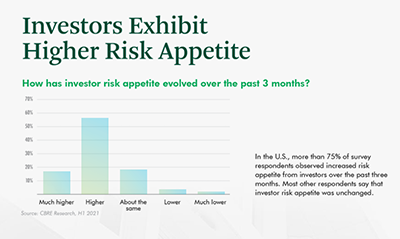
Many Markets See Commercial Real Estate Values Return to Pre-Pandemic Levels

Commercial real estate values have returned to pre-pandemic levels in many U.S. markets, continuing a recovery that began at year-end 2020, said CBRE, Dallas.
“The rapid recovery across U.S. real estate markets was mostly made possible by the massive fiscal and monetary response to the COVID-19 downturn that stabilized the economy and benefited property values,” said Chris Ludeman, Global President of Capital Markets for CBRE. “While some uncertainty remains, a strong economic recovery will continue to benefit property fundamentals, investment volumes and values.”
The CBRE U.S. Cap Rate Survey found that more than two-thirds of real estate investors exhibited increased risk appetite in first-half 2021. Investors now broadly expect cap rates to remain stable or compress across most property types through the end of the year.
CBRE examined capitalization rates for stabilized properties and investment sentiment on market conditions. Cap rates measure a property’s value by dividing its annual income by its sale price and a lower cap rate generally indicates a higher value.
Looking at investment sentiment, more than 75 percent of real estate investors indicated their risk appetite increased during the first half of 2021. This corresponds with transaction volumes that were up 32 percent year-over-year in first-half 2021 and CBRE’s forecast for a strong year of investment activity.
Investors expect cap rate movement to vary across property types in the second half of the year. Cap rates will likely continue to compress for industrial and multifamily properties in most markets, while rates are expected to largely remain flat for office, retail and hotel assets, CBRE said.
For cap rates, CBRE compared cap rates with the pre-pandemic levels in second-half 2019, rather than the pandemic-disrupted second-half 2020. “Today cap rates across property types are at or below pre-pandemic levels in many markets,” the report said.
The pandemic did affect some real estate sectors more than others. Every industrial market reported lower cap rates than in 2019, reflecting strong investor appetite because of increased e-commerce demand during the pandemic. Suburban multifamily assets were more resilient than their urban counterparts. Office cap rates remained stable or compressed across most large 25 markets. The report noted come cap rate compression may be due to changes in underwriting as lower net operating incomes impact cap rates.
“Investors were willing to purchase industrial and multifamily assets at a premium,” the report said. “Investors sought mostly small to moderate pricing discounts for office assets, and moderate to large discounts for retail properties and hotels.”
